The study’s scope refers to the specific parameters of the research, establishing what is included and excluded. It is crucial to clearly define the subject of study and identify the factors that fall within the accepted range. For example, if the research concentrates on exploring the adverse effects of bullying on middle school students, the scope may encompass both traditional bullying and cyberbullying among students in grades 6 to 8.
Limitations in a study occur when factors arise that are beyond the control of the researcher, restricting the scope and potentially affecting outcomes and conclusions. All studies, regardless of their quality, have limitations. That’s why terms like “prove” and “disprove” aren’t used to describe research findings since future research could question hypotheses or conclusions. Limitations may involve limited access to individuals, documents, or data within an organization. Nonetheless, these limitations can be overcome by future studies.
One limitation of qualitative research is its connection to validity and reliability. According to Wiersma (2000), it is challenging to replicate qualitative studies due to their occurrence in a natural setting (p. 211). In addition, certain methodologies and designs, like phenomenology, entail limitations that researchers may have limited control over.
Case studies lack the capacity to establish cause and effect relationships due to their inability to eliminate alternative explanations. Additionally, their findings are not universally applicable as they solely concentrate on one entity’s behavior. The behavior observed in a single case may or may not mirror that of similar entities. Although case studies provide valuable insights into potential observations within comparable organizations, additional research is required to validate the applicability of these findings in other contexts.
Correlational research shows that the behavior of one variable can be predicted based on the behavior of another variable, indicating an association between them. However, this association does not necessarily imply a causal relationship. If X is associated with Y, it could mean that X caused Y, Y caused X, or some other confounding variable caused both X and Y without a direct causal link. Additionally, correlational research may have limitations in terms of generalizability. The study might have focused on a specific group of individuals or examined the relationship between variables under particular circumstances. Therefore, it remains uncertain whether the findings from correlational research can be applied to other people or situations.
Randomly assigning participants in experiments can lead to causal conclusions if there are no confounding variables. The rigor of experiments is improved by controlling for external influences on the variables of interest. However, there may still be limitations when generalizing the results. The experiment may have focused on a specific group of people, particular situations, and specific conceptualizations of variables. As a result, it remains uncertain whether the findings can be applied to other individuals, situations, or conceptualizations of the variables. Although significant findings from an experimental study can suggest a general cause within certain boundaries, there may be limitations due to unmeasured variables.
Delva, Kirby, Knapper, and Birtwhistle (2002) pointed out that surveys distributed with time constraints can be problematic as individuals who feel time-constrained are less likely to respond. These potential participants often perceive themselves as overworked and therefore lack the time to complete the survey. Surveys also tend to restrict respondents by forcing them into predefined response categories, thus limiting the variety of responses. Unlike interviews, where respondents have the opportunity to seek clarification, survey respondents primarily rely on the survey’s text for guidance on how to complete and provide answers.
The delimitations of a study refer to the characteristics that arise from limitations in the scope of the study and from conscious decisions made during the development of the study plan. These delimitations are different from limitations, which are inherent to the method and design. Delimitations are specific choices made by the researcher, including objectives, questions, variables, theoretical perspectives, paradigm, methodology, theoretical framework, and participant selection.
The initial step in delimiting is selecting a problem, indicating that there were other related problems that could have been chosen but were rejected or excluded from consideration. To clarify the limitations of your study, review each decision you made when putting it together. In your purpose statement, you state what your study aims to achieve. In the delimitations section, you can repeat this statement and also mention what aspects the study does not aim to cover. In the latter situation, your decisions to exclude certain endeavors are likely based on criteria such as lack of direct relevance, too problematic due to certain reasons, or not feasible. Clearly explain this reasoning to the best of your ability.





